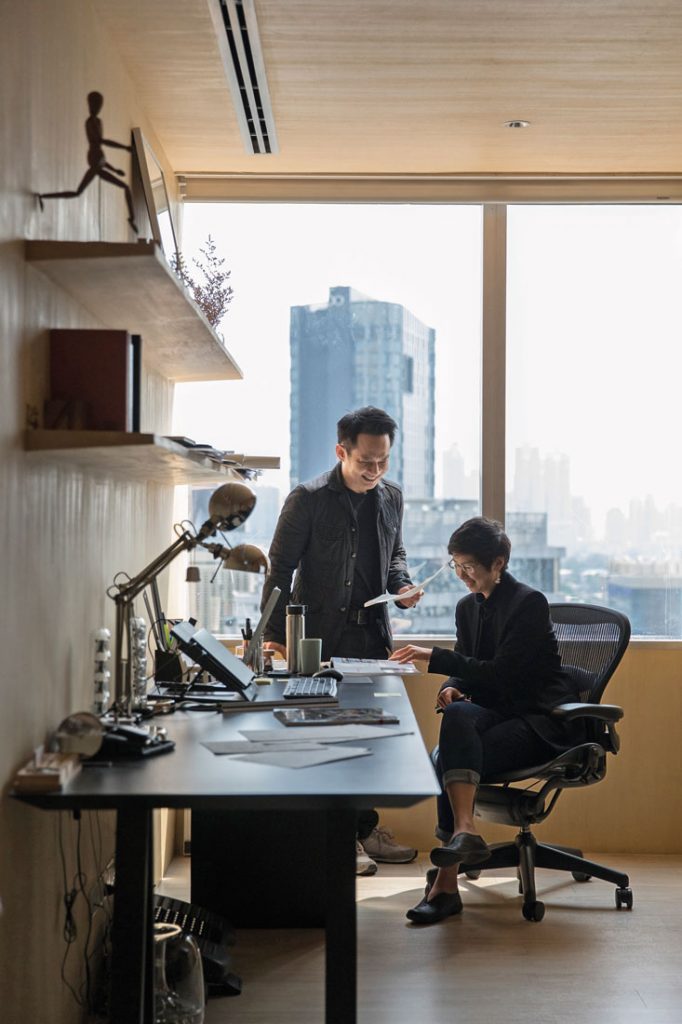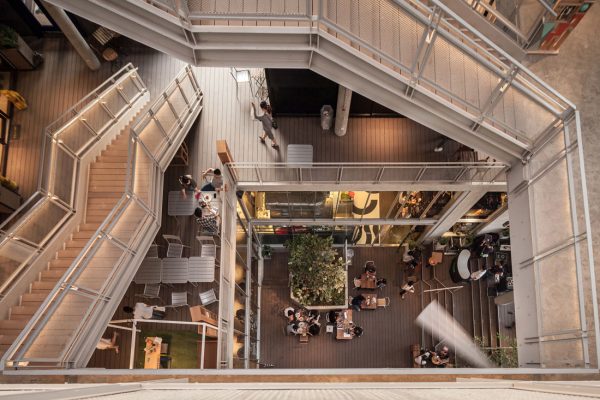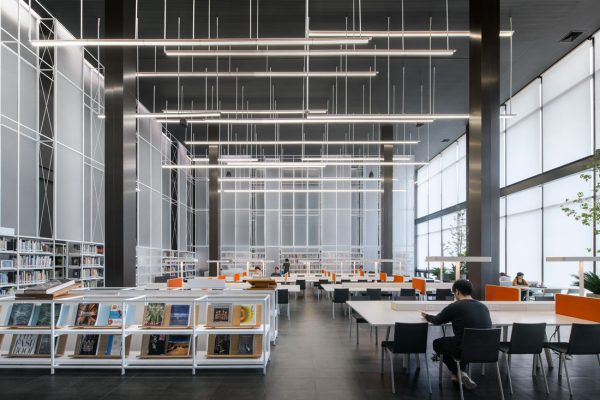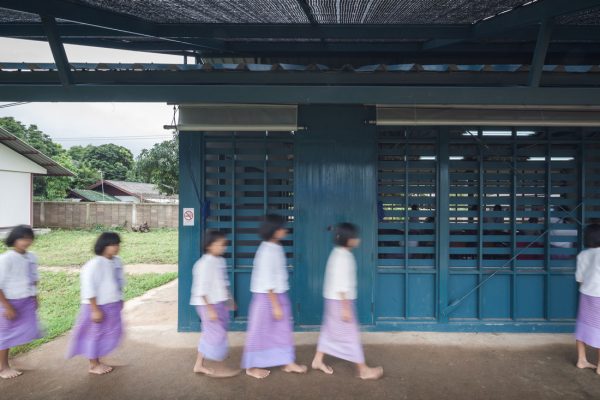For Thai firm Department of ARCHITECTURE, design must correlate with its context, its climate and the available resources if it is to make sense now and into the future.

Amata Luphaiboon and Twitee Vajrabhaya Teparkum – founders of Department of ARCHITECTURE. Photo by Adit Sombunsa
August 17th, 2018
On a typically restless morning in Bangkok, I meet with Amata Luphaiboon and Twitee Vajrabhaya Teparkum – the founders of Department of ARCHITECTURE. Their office is nested on the eighteenth floor of a building in the Sathorn district. Although the ambience outside is a little too bustling due to the typical traffic jam of this CBD area, their workspace is a mix of tranquility and fun energy, just like their architecture.

Amata Luphaiboon and Twitee Vajrabhaya Teparkum – founders of Department of ARCHITECTURE. Photo by Adit Sombunsa
“We started off with only a couple of younger junior architects. From the very first day we were very excited by all the possibilities out there. Even after 14 years, what feels the same is that these possibilities still excite us,” says Luphaiboon. The origin of their office can be traced back to the time when he and Teparkum were working in the architecture team at the engineering-based firm Metric & Co. After the two made names for themselves with their work on the award-winning Sila Evason (now Six Senses) Hideaway Resort in Samui, they decided to open Department of ARCHITECTURE in 2004.
While most of the studio’s early projects were for the hospitality sector, their years of experience have contributed to a greater diversity of works with varying scales, building types and functional programs. The one thing that has never changed when it comes to their work is the freshness of ideas and incredible attention to details. “It always feels fun to explore new things,” says Luphaiboon. “It isn’t just about the look or the concept; it could be new details, new programs or new thought process. It could be anything,” adds Teparkum.

The Commons. Photo by Ketsiree Wongwan / W Workspace
The Commons is one of the manifestations of their restless energy. The way they explored the facade’s material composition, which includes expanded metal, not only resulted in the project’s interesting physical appearance, but helped to achieve its unusual program. The open-air mall is the new backyard of Bangkok’s urban Thonglor neighborhood, where people meet and interact on common ground. It is a public space that Bangkok rarely sees.

Thailand Creative and Design Centre. Photo by W Workspace
“For every project, we don’t start with how we want a building to look but rather an understanding of every aspect of the project and brief. Then we explore the interesting elements that can be translated into the core concept of the design,” explains Teparkum about their process. For the new headquarters of Thailand Creative and Design Center (TCDC) at the Grand Postal Building, they worked with a historic 80-year-old edifice. Their understanding of the area’s historical context and the project’s own program (including the client’s aim to access a wider group of entrepreneurs) were central to the development of the design. The result is a dialogue between the old building envelope and the new functional elements, causing the project to be more than just a renovation but the beginning of the architecture’s new and sustainable journey into the future.

Pong Phrae Wittaya School (emergency classroom). Photo by Spaceshift Studio
When asked what sustainability is for Department of ARCHITECTURE, the two founders answer: “It’s about design that makes sense.” By ‘makes sense’ they mean design that corresponds with the context, climate and available resources. The design of the emergency school building they created with non-profit organisation Design for Disasters in Chiangrai is a testament to this statement. The structure, for earthquake-devastated Pong Phrae Wittaya School in northern Thailand, was derived from a simple seismic design concept. But it transforms a rural classroom block from ‘just a building’ to an interesting piece of ‘architecture’ with an elegant exposed structure and a backstory of the overcoming of significant challenges related to limitations of time and budget.
Luphaiboon and Teparkum pause for a moment before bursting out a big laugh when I ask about the what the ‘architecture of tomorrow’ will be in their view. “That’s a big question,” they say, but they answer it anyway. The notion of the ‘architecture of tomorrow’ is somewhat unpredictable. They think that while the direction today’s architecture is going remains unclear, the individuality of each architect will become even more discernible with new design technologies as a key influence on their work. Such individuality could be expressed in a highly visual form or more indirectly and abstractly, they say. Department of ARCHITECTURE sees itself more aligned with the latter.
This article first appeared in Cubes issue 91. Project photos courtesy of Department of ARCHITECTURE.
A searchable and comprehensive guide for specifying leading products and their suppliers
Keep up to date with the latest and greatest from our industry BFF's!

Savage Design’s approach to understanding the relationship between design concepts and user experience, particularly with metalwork, transcends traditional boundaries, blending timeless craftsmanship with digital innovation to create enduring elegance in objects, furnishings, and door furniture.

The Sub-Zero Wolf showrooms in Sydney and Melbourne provide a creative experience unlike any other. Now showcasing all-new product ranges, the showrooms present a unique perspective on the future of kitchens, homes and lifestyles.

Suitable for applications ranging from schools and retail outlets to computer rooms and X-ray suites, Palettone comes in two varieties and a choice of more than fifty colours.

Channelling the enchanting ambience of the Caffè Greco in Rome, Budapest’s historic Gerbeaud, and Grossi Florentino in Melbourne, Ross Didier’s new collection evokes the designer’s affinity for café experience, while delivering refined seating for contemporary hospitality interiors.

Inspired by a forest of stone, and created as a place to showcase the iconic Italian furniture brand Zanotta, this retail space is unconstrained in its vision of what a new-age shopping experience should be.

Reinvigorating its local Angsila economy, this pavilion in Thailand becomes a floating restaurant where fishermen and visitors can select and eat their own oysters. No wonder it won The Influencer award at INDE.Awards!

INDE.Award-winning studio, HAS Design and Research, may be young but its projects reflect a talent far beyond its practice years. Its vision translates into a new and beautiful reality designed to stimulate mind, body and soul.

As an architecture practice, HAS design and research is leading the way, creating inspirational projects with ingenuity and originality. They are projects that always amaze and The Glade Bookstore in downtown Chongqing is no exception.
The internet never sleeps! Here's the stuff you might have missed

Swiss home appliance designer and manufacturer V-ZUG’s first Sydney studio is a unified expression of the brand’s boutique, sustainable and design-led identity.

Simon Liley, Principal Sustainability Consultant at Cundall, writes about how cyberpunk dystopias haven’t (quite) come to pass yet – and how designers can avoid them.